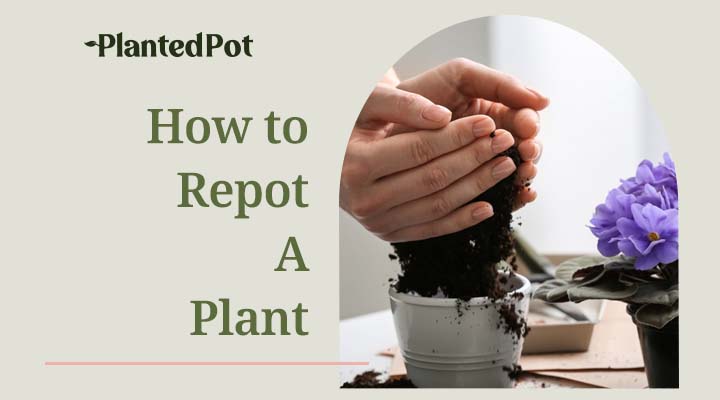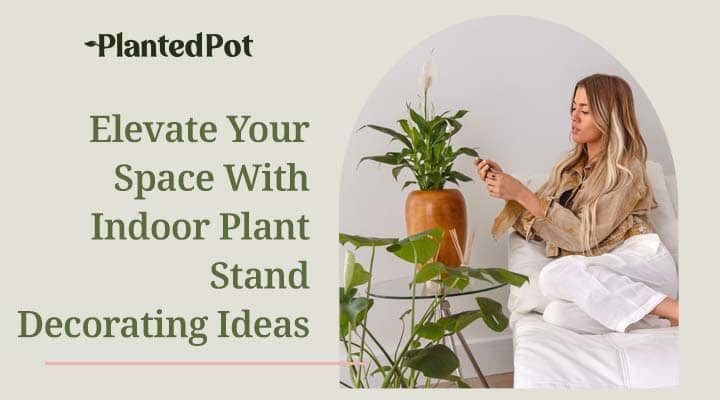
Anthurium Plant Care: 7 Simple Tips for Optimum Growth
Home / Anthurium Plant Care: 7 Simple Tips for Optimum Growth
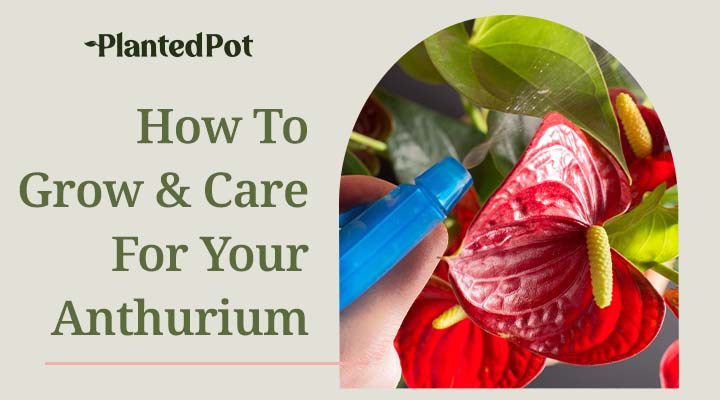
Anthurium Plant Care: 7 Simple Tips for Optimum Growth
- Kyle Chin
- March 9, 2021
- 11:24 pm
- No Comments
Anthuriums are amazing, brightly-colored tropical plants that are perfect for households and extremely easy to care for. These beautiful plants bloom year-round and can make a great addition to any home. With very little effort and minimal attention needed, any plant owner, from beginners to veterans, can make the anthurium plant part of their home collection!
Read on to find out why the anthurium is one of the most popular household plants worldwide. Learn how to take care of your plant and how you can ensure it can stay bright and colorful!
What is an Anthurium Plant?
The anthurium is THE world’s longest blooming plant and often goes by tailflower, flamingo flower, or laceleaf. Anthuriums are native to the tropical forests in Central and South America but can also be found in parts of the Caribbean.
Anthuriums are classified as epiphytes, which are plants that attach their roots close to trees and grows along the surfaces. They are part of a larger family of flowering plants, Araceae, which include peace lilies and philodendrons.
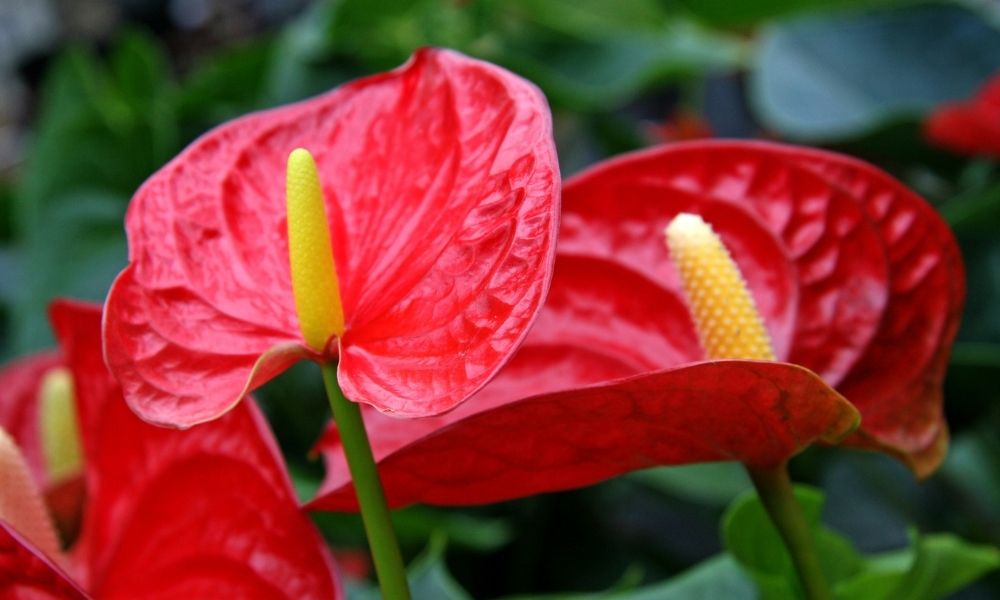
There are over 1,000 species of anthuriums, all in different colors and shapes! The most popular anthuriums are prized for their brightly-colored spathes and waxy green leaves. They have a spike-like spadix in the center surrounded by colorful spathes (or bracts), typically club or heart-shaped.\
These spathes can come in various colors such as pink, purple, white, green, red, or a combination of multiple colors. Other varieties of anthuriums grow green foliage that has large leaves with no flowers.
Popular Anthurium Plant Types:
- Flamingo Flower (Anthurium andraeanum) – The first anthurium to officially be recorded, the Flamingo Flower has vibrant fire-red spathes and a bright yellow spadix.
- Tulip Anthuriums (Anthurium amnicola) – Slightly smaller than the Flamingo Flower, Tulip Anthuriums have a bright purple spadix and light pink, tulip-shaped spathes.
- Black Anthurium (Anthurium watermaliense) – Black Anthuriums, also known as black queen anthuriums, have deep purple, almost black-colored spathes.
- Bird’s Nest Anthurium (Anthurium hookeri) – The Bird’s Nest Anthurium has large, oval, shiny green leaves that resemble big spoons. The leaves typically have tiny, black spots on them as well.
- Ace of Spades (Anthurium Crystallinum) – This popular species of anthurium can grow up to 3 ft. tall and has large, spade-shaped leaves that can grow up to 2 ft. across. Each leaf has deep white veins that make this plant stand out over the rest.
Are Anthurium Plants Easy to Care For?
Yes, anthuriums are very easy to care for! They don’t require a lot of attention, but you can ensure its growth and preserve its year-round bloom with proper care. Each bloom usually lasts around 2-3 months before starting over again.
Can You Grow an Anthurium Plant Indoors and Outdoors?
You can grow anthurium plants both indoors and outdoors, but they typically thrive in warmer, more humid conditions. If the outdoors can get cold, it may be better to raise your anthurium indoors to prevent the plant from dying. Anthuriums also do not like direct sunlight, so make sure to plant in a shaded area if grown outdoors or keep inside for bright indirect light.
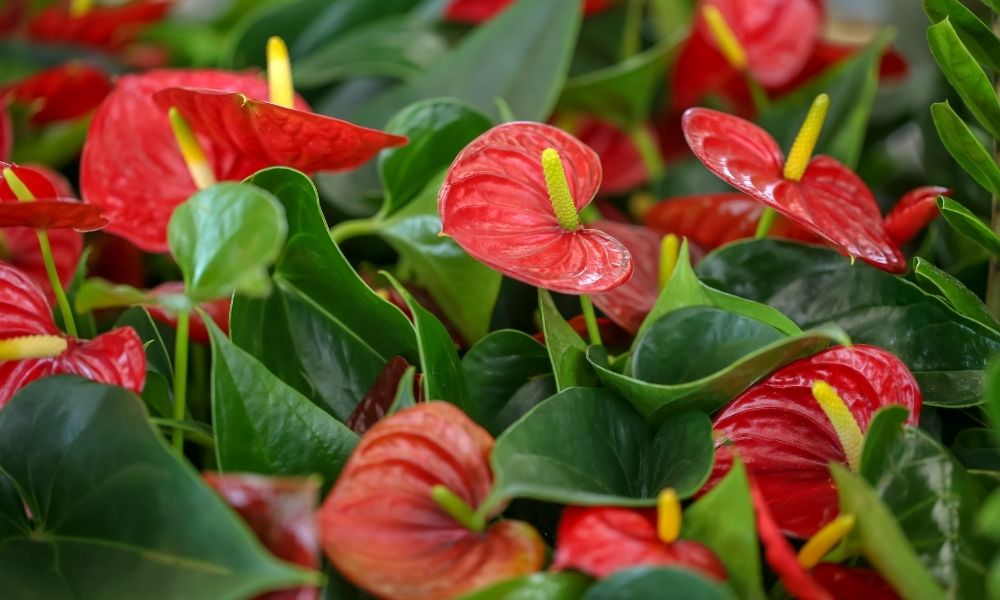
What Are the Benefits of Anthurium Plants?
Anthuriums are great household plants that can have many benefits for your health, such as:
- Better air quality – Anthuriums absorb carbon dioxide and produce oxygen, acting as an air purifier. Anthuriums can also absorb other toxins and chemicals, like formaldehyde, benzene, carbon monoxide, in the air to improve overall air quality inside your house.
- Lower stress levels – One 2015 study found that indoor plants were able to help reduce stress levels. Interacting with plants by simply tending to them or staring at them lowered stress levels in the study participants. By absorbing the toxins in the air, many people reported being able to focus better and work more efficiently when they had plants on their desks.
In many cultures, anthuriums also symbolize hospitality, warmth, and generosity that make this plant an excellent centerpiece or housewarming gift. Asian cultures believe anthuriums help increase feng shui, or spiritual energy, inside the house and help bring good luck and prosperity! Different colors can also mean various things, such as pink and red for love or green for hope.
How to Care for Anthurium Plants
Before you plant an anthurium, consider their environment for lighting, temperature, and humidity. Indoor anthuriums can typically grow up to 2-3 ft. tall. However, they can vary depending on the type, giving them enough room to grow. Since they are epiphytes, prepare a stick to provide support and to encourage plant growth.
Finding the Right Pot
Find a well-draining pot that is slightly larger than the plant’s roots. The pot needs to have drainage holes so that the soil does not retain too much moisture, leading to root rot. Typically, terracotta or clay pots work best since they are porous and can allow the water to evaporate more easily.
Plan to re-pot your anthurium about once every two years until full maturation. You’ll know when to re-pot when the bottom of the roots begins to poke out from the soil on top or bottom. Use a new pot that is about 2 inches larger and use new soil.
Choosing the Right Soil
The best soil for anthuriums is a low-moisture, coarse, well-draining potting mix. The goal is to recreate the natural growing conditions of anthuriums as much as possible, where they grow on the sides of tropical forest trees.
A good mixture for a customized potting mix is:
- Pine or fir tree bark [1 Part]
- Peat moss [1 Part]
- Perlite [1 Part]
Or
- 5 parts low-moisture regular soil
- 2 parts orchid potting mix
- 2 parts peat moss
- 1 part perlite
Watering Your Anthurium Plant
Although anthuriums like moisture and humid environments, they can still suffer from overwatering. Pots that are not well-drained keep in the water, which can lead to root rot, killing the plant. Allow the soil to dry out almost completely before watering again.
Typically, during the warmer seasons, water about once or twice a week. In the colder seasons, you can water once every 2-4 weeks. You can use a water meter to check if the soil is dry or wet at the root level.
When watering, thoroughly soak the soil until the water permeates the bottom of the plant. Allow the water to drain out before placing it back in its original spot. Check back later in the week or month, depending on which season it is.
Caution: Try to use filtered or mineral water for your plant. Regular tap water may contain traces of fluoride, mercury, chlorine, and other chemicals that can irritate or even damage your anthurium.
Placement and Lighting
The ideal placement and lighting for anthuriums should be under indirect sunlight in a warm area. Similar to their natural tropical habitats, their placement should mimic filtered sunlight through the trees. Any direct sunlight could potentially burn the plant and the leaves.
A south-facing window is a great place for the anthurium to receive indirect sunlight throughout the day. If you plan to grow the anthurium outdoors, plant it in an area where it has a little bit of shade and away from the sun.
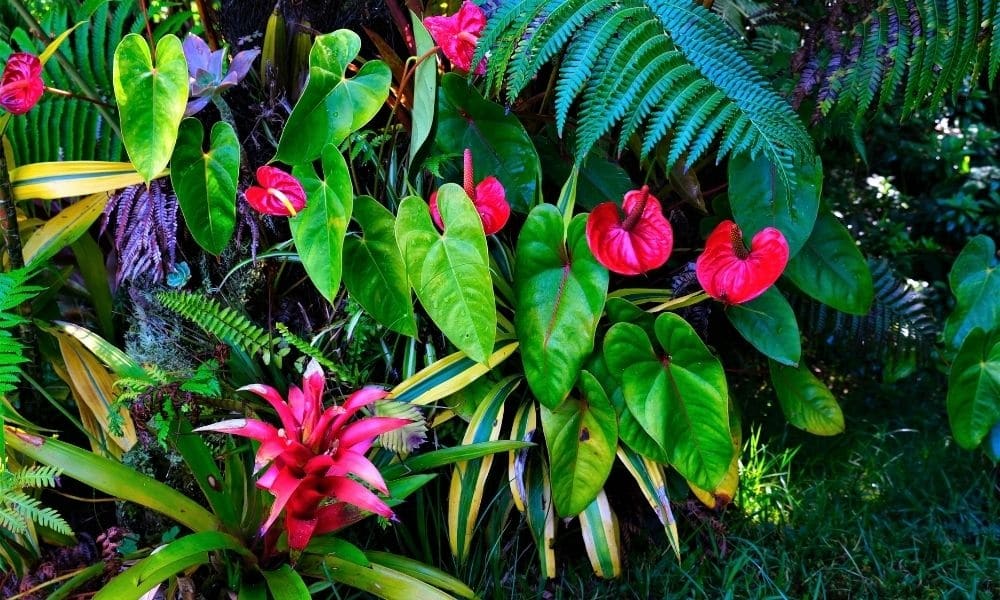
Humidity and Temperature
High humidity and warm temperatures are best for anthuriums to thrive, similar to their native tropical conditions. Ideally, you want to keep temperatures between 65-85°F and around 40-50% humidity. Try to keep temperatures above 60°F at the minimum, or the anthurium will start to die.
If you live in a dry climate area? Consider using a humidifier or place the plant above wet rocks to allow moisture to surround the plant. The air also tends to get drier during cold seasons, so you may also need to keep the plant humid during these times.
Pruning an Anthurium Plant
Anthuriums don’t need much pruning as they typically grow pretty healthy. However, if you notice discolorations or withered blooms, you can use a sharp, clean shear to snip off the affected areas. You can also trim the stems near the base if they are growing too long.
Anthurium plants can be cut off to four leaves remaining and continue growing. However, in most cases, you will not need to prune to this extent (unless the plant is experiencing fungal rot). Remember to use clean, sharp shears! This is to ensure there’s no bacterial infection or tearing in the stems to allow healthy regrowth.
Feeding Anthurium Plants
Anthurium plants should not be over-fertilized and generally do well with very little fertilizer. Over-fertilizing can harm the plant and potentially burn the roots. Use a 1/4-strength fertilizer that is high in phosphorus about once a month for best results.
Common Anthurium Plant Care Issues
Some common anthurium plant issues are:
- Roots growing above or below soil – Typically, this means the plant is root-bound and outgrowing the pot. The roots usually start to grow throughout the soil and back upwards or through the bottom of the pot. Re-pot as soon as possible for your anthurium to continue growing properly.
- Pests or insects – Anthuriums are susceptible to pests like mealybugs, spider mites, scales, or aphids. Try using plant-safe pest remover or rubbing alcohol to remove the pests carefully.
- Yellowing leaves – Yellowing leaves can mean a few different things. It could be your anthurium isn’t getting enough sunlight, too much or too little water, or the plant is root-bound (not enough nutrients). Determine the source of the problem and adjust accordingly.
- No bloom – Anthuriums should be blooming year-round once they reach full maturity. If your plant is not blooming, it could be a sign that it lacks nutrients, sunlight, or water.
- Fungal rot – Fungus or root rot can cause the plant to suffer and, in some cases, die. Try trimming off rotting stems or leaves and adjust your plant care routine to allow your anthurium to regrow.
How Do I Know if My Anthurium Plant is Dying?
Common signs that your plant is dying are:
- Leaf and stem discoloration (yellowing or browning)
- Black spotting indicating a fungal or bacterial infection
- Slimy or soft roots
- Wilting flowers
- Drooping stems
Are Anthurium Plants Poisonous?
Yes, anthurium plants are poisonous and can cause extreme pain if ingested. Anthurium plants have calcium oxalate crystals in every part of the plant that can cause a severe burning sensation if ingested. Rough handling of the plant can also release these crystals and cause skin inflammation or irritation. Put the anthurium away from small children or pets to avoid any problems.
Final Thoughts – Anthurium Plant Care
Anthuriums are wild, tropical plants that you can tame and make a great addition to your home. The anthurium is beautiful yet low-maintenance that should put them at the top of everyone’s list. Pick one up and find out why they are one of the world’s most popular indoor plants!
Related: Philodendron Care: An Easy-to-Use Grow Guide for Plant Enthusiasts



